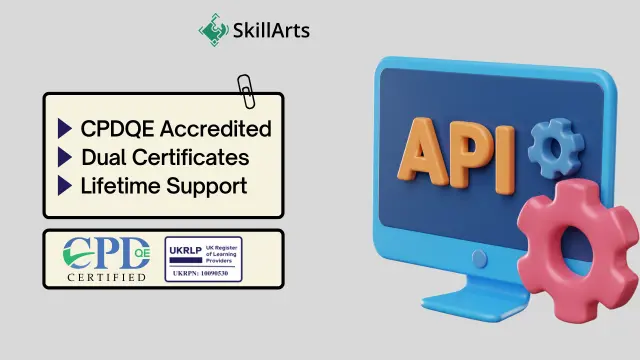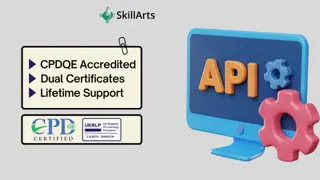
Create Restful APIs using PHP, POSTMAN and MySQL: Secure API
CPDQE Accredited | Dual Certificates | Lifetime Access | Easy Refund
Skill Arts
Summary
- CPDQE Certificate on API training - Free
- Reed Courses Certificate of Completion - Free
- Tutor is available to students
Add to basket or enquire
Overview
Why Study This Diploma in Creating Restful API - CPD Certified?
- A study by PwC UK found that API adoption grew by 200% in the UK between 2020 and 2023.
- According to Reed, job postings for "API Specialist" or "API Developer" have increased by 35% YoY in the UK (as of April 2024).
- A report by APImetrics states that globally, there were over 380 million public APIs available in 2023, with an estimated growth of 25% by 2025.
Learning Outcomes:
- Learn how to create and manage APIs using PHP and MySQL.
- Master CSS from basic to expert levels to enhance the front-end design of your API interfaces.
- Learn to implement authentication and security features in your APIs.
- Develop real-world applications that demonstrate your mastery of PHP, POSTMAN, and MySQL for API development.
- Learn to interact with MySQL databases, performing queries and managing data for your APIs.
CPDQE Accreditation
This Diploma in Creating Restful API is CPDQE accredited. CPD is a globally recognised parameter for continuous professional development acknowledged by thousands of professional bodies, employers and academic institutions in the UK and around the world.
Dual Certificates
After completing this Diploma in Creating Restful API Course, you will receive a course completion certificate from Reed. Also, you will receive a CPDQE-accredited signed certificate from SkillArts.
Certificates
CPDQE Certificate on API training
Digital certificate - Included
Reed Courses Certificate of Completion
Digital certificate - Included
Will be downloadable when all lectures have been completed.
Curriculum
-
Introduction 43:37
-
CSS Basic 1:17:08
-
CSS Intermediate 1:37:54
-
CSS Advanced 1:24:29
-
CSS Expert 44:18
-
Restful API Introduction 39:37
-
Restful API Basic 27:38
-
Project1: Restful API Authentication 1:47:19
-
Project2: Restful API - MySQL 25:00
-
Restful API – Web API Services 33:57
-
MYSQL introduction 44:16
-
MySQL basic 56:07
-
MySQL filtering data 1:00:04
-
MySQL functions 46:00
-
MySQL joins 1:04:40
-
MySQL advanced commands 1:13:16
-
MySQL structure creation 35:22
-
MySQL data queries 22:02
-
MySQL structure queries 14:50
-
MySQL constraints 17:08
-
MySQL backup and restore 24:19
Course media
Description
Diploma in Creating Restful API Course Syllabus
Introduction:
- Understand the basics and significance of Restful APIs, PHP, POSTMAN, and MySQL in web development.
CSS Modules:
- CSS Basic:
- Learn the fundamentals of CSS for styling web pages for API interfaces.
- CSS Intermediate:
- Build on basic knowledge to create more complex styles for API front-ends.
- CSS Advanced:
- Master advanced CSS techniques for sophisticated API designs.
- CSS Expert:
- Achieve expert-level proficiency in CSS for professional-quality API web designs.
Restful API Modules:
- Restful API Introduction:
- Gain an introduction to Restful APIs and their importance in modern web applications.
- Restful API Basic:
- Learn the basic concepts and techniques for creating APIs using PHP.
- Project 1: Restful API Authentication:
- Implement authentication mechanisms for secure APIs using PHP and POSTMAN.
- Project 2: Restful API - MySQL:
- Integrate MySQL with Restful APIs for dynamic data management.
- Restful API – Web API Services:
- Develop robust web API services using PHP and MySQL.
MySQL Modules:
- MySQL Introduction:
- Understand the basics of MySQL database management for APIs.
- MySQL Basic:
- Learn basic commands and operations for MySQL databases used in APIs.
- MySQL Filtering Data:
- Master techniques for filtering data in MySQL for API responses.
- MySQL Functions:
- Utilize MySQL functions to perform complex data manipulations for APIs.
- MySQL Joins:
- Learn to combine data from multiple tables using joins for comprehensive API responses.
- MySQL Advanced Commands:
- Gain proficiency in advanced MySQL commands for intricate data operations in APIs.
- MySQL Structure Creation:
- Understand how to create and manage database structures for APIs.
- MySQL Data Queries:
- Develop skills in querying data effectively for API functionalities.
- MySQL Structure Queries:
- Learn to write queries that interact with the database structure for APIs.
- MySQL Constraints:
- Implement constraints to ensure data integrity in APIs.
- MySQL Backup and Restore:
- Master techniques for backing up and restoring MySQL databases used in APIs.
Questions and answers
Currently there are no Q&As for this course. Be the first to ask a question.
Reviews
Currently there are no reviews for this course. Be the first to leave a review.
Legal information
This course is advertised on reed.co.uk by the Course Provider, whose terms and conditions apply. Purchases are made directly from the Course Provider, and as such, content and materials are supplied by the Course Provider directly. Reed is acting as agent and not reseller in relation to this course. Reed's only responsibility is to facilitate your payment for the course. It is your responsibility to review and agree to the Course Provider's terms and conditions and satisfy yourself as to the suitability of the course you intend to purchase. Reed will not have any responsibility for the content of the course and/or associated materials.


